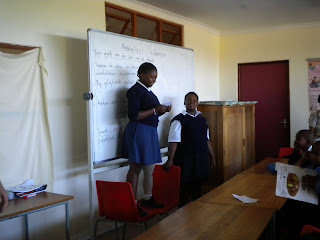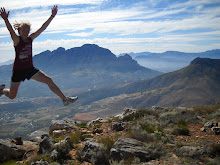It’s been over a week since my last entry and I wanted to share the details of my last two weeks at Lynedoch with you. I’ll start with last Monday. For our physical exercise period we played kickball and it was a lot of fun. I was really pleased with some of the boys who made sure that each girl on their team got a chance to kick. Because South Africa is an extremely patriarchal society, and that idea is reinforced in every realm, the girls tend to take a back seat to the boys during our physical activities. I wasn’t sure how involved the girls would get but, after some brief hesitation, they jumped right in thanks to Nielen and Avron’s encouragement. When it was Siziwe’s turn to kick another awesome thing happened. She’s the biggest girl in the class and tends to skip out entirely when we do physical activities. But my classmate Jeff and a bunch of the learners started chanting her name and encouraging her to step up to the plate. After a minute of cheering she stepped up and kicked a home run. I could tell she was very pleased as she crossed the plate and everyone gave her a high five. I left the game feeling very happy about the way things unfolded.
During our first classroom lesson after kickball we taught the kids about nutrition. We showed them how to read food labels, what’s good for you and what’s not so good. We split them up into small groups and passed out some food labels for them to look at and decipher. Than we taught them about the food pyramid and how many servings of each group you’re supposed to have each day. They were really happy that we gave them a worksheet on the topics because they enjoy pasting them into their workbooks. While preparing this lesson and then again while teaching it I was acutely aware of the fact that none of my learners are getting the appropriate amount of nutritious food each day. It’s important for them to understand food labels and the food pyramid, but it’s tough to know that this knowledge probably won’t help them gain access to more food.
For our afternoon lesson we diagramed photosynthesis on the marker board and talked briefly about when plants need to grow. Then we headed outside and let them plant green beans and carrot seeds in a section of the garden that belongs to Grant. They got a little chaotic outside but I think they enjoyed the opportunity to work in the garden.
Our yoga session ended a little early last Monday because Bryce had a meeting, so some of us spent the extra time sitting in on Grant’s class of 7th and 8th grade boys. While we were in there Jonathan stood up and thanked us for attending his mother’s funeral. That’s all he said, but we all knew this was a big deal for him. Jonathan is one of the quietest kids in the school and he’s never spoken in front of his own class before. My friends that work in his class have rarely heard him talk. But Grant told us that Jonathan had approached him that morning and asked if he could make a speech in front of us. It was really touching to see him stand in front of all of us, knowing that he’d never done something like that before.
So that was last Monday. As for this Monday, we began with a fun game of tag to get the kids running around. It was really hot out and I was quite sweaty by the end of it. Afterwards we let the kids teach us a clapping game that they all like to play. Both the boys and girls enjoyed playing and it’s something that the entire class can do together, so I think we’ll incorporate it into more of our physical lessons. Once we were back inside we taught the learners about human rights and children’s rights. South Africa has specific rights for children and the 6th grade curriculum mandates that the learners know about their rights. We gave the kids a worksheet with the 10 rights on it and let them take turns reading out loud. This lesson was a struggle for me, for the same reason as the nutrition lesson. One of the rights says that children should be protected from abuse, another says that they should have food and healthcare, and another says that they should be free from labor. These are all rights that don’t necessarily hold true for some children in Lynedoch. Regardless of this, or maybe especially because of this, it’s important that they know what they are entitled to at birth. After going over the rights I read the class a book (‘For Every Child’) about the children’s rights as stipulated by the United Nations.
In the afternoon we divided the class into groups of 2, 3, or 4 learners and gave each group the script for a skit that we prepared ahead of time. Each skit modeled one of the children’s rights. After giving them some time to look over the script and become comfortable with their roles, we let each group act it out in front of the class. Most of them really enjoyed the chance to show off in front of their classmates. I was most impressed with Siziwe, the unsuspecting star of the kickball game, as she was a great actress. She spoke loudly and clearly, her English pronunciation was nearly perfect, and she took it upon herself to perform in two skits. It was a whole other side of her that we hadn’t been exposed to yet; this side of her was confident and comfortable. Some of the girls asked if we could let them write their own skits for next week’s human rights lesson, so next Monday should be a lot of fun.
Here are some pictures of my learners doing their skits!


Also, if you're interested, check out South Africa's national anthem. It's really beautiful and incoporates the 5 most common languages out of the 11 official ones of the country.







 a typical house on the farm
a typical house on the farm the communal bathrooms
the communal bathrooms the chapel on the farm
the chapel on the farm
 the view from my bedroom window!
the view from my bedroom window! a marketplace with lots of African things
a marketplace with lots of African things some of the little kids at school dressed in red for Valentine's Day
some of the little kids at school dressed in red for Valentine's Day






